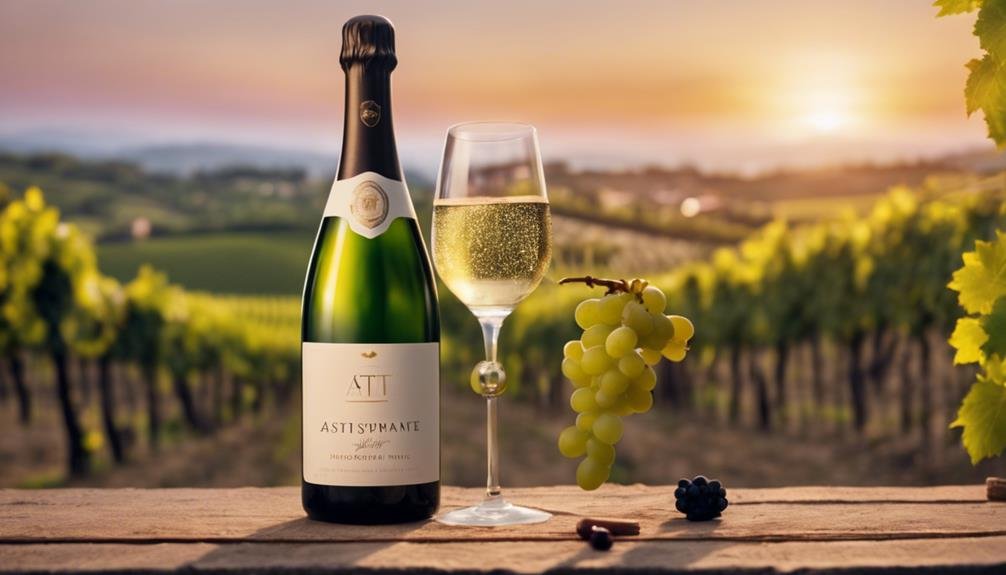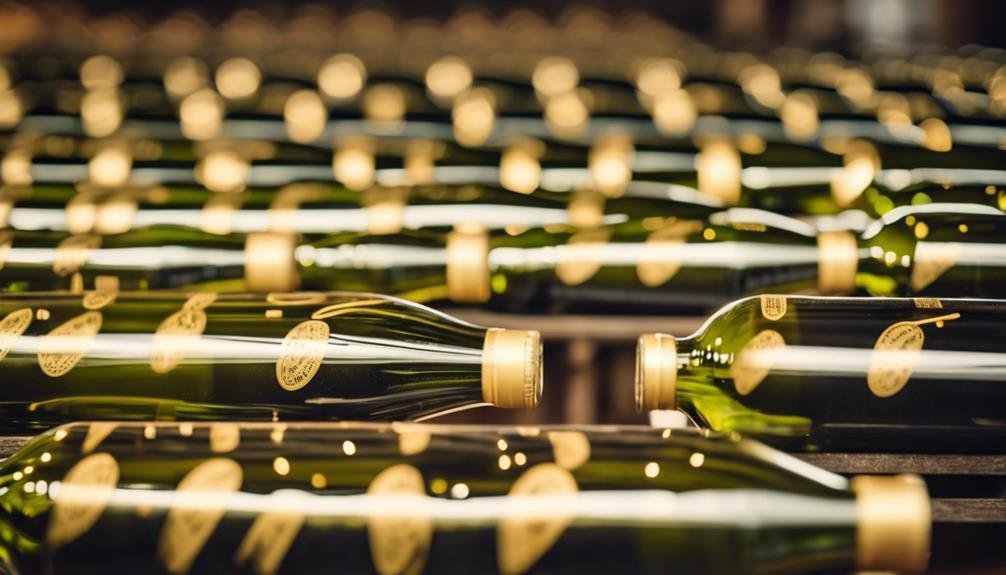Explore the world of Italian sparkling wines with Prosecco and Asti Spumante. Prosecco, with its fruity aroma, complements appetizers and seafood. Valdobbiandene Proseccos age gracefully. Asti Spumante, sweet and made from Moscato grapes, pairs well with desserts. Uncover the rich history and cultural significance of Spumante in Italy, a symbol of celebration. To choose the perfect sparkling wine, consider food pairings and aging potential. Venture into different Italian regions for unique tasting experiences and learn about the Metodo Classico production method. The effervescent charm of Italian wines promises a delightful sensory journey into the world of sparkling delights.
Varieties of Sparkling Italian Wines
When delving into the world of sparkling Italian wines, one encounters a diverse array of varieties that showcase the country's rich winemaking heritage and traditions.
Prosecco, renowned for its aromatic and fruity profile, pairs excellently with appetizers, seafood, and light pasta dishes. It is best enjoyed young, but quality Prosecco wines from the Valdobbiandene region have aging potential, developing more complexity over time.
Asti Spumante, made with Moscato grapes, is a sweet sparkling wine ideal for desserts and fruit-based dishes. While generally not considered high-quality, some Moscato d'Asti versions offer a more refined experience.
Understanding the food pairings and aging potential of these Italian sparkling wines can enhance your enjoyment and appreciation of their distinct characteristics.
Characteristics of Prosecco Wines
In exploring the world of sparkling Italian wines, a standout variety known for its distinctive characteristics is Prosecco. Prosecco is aromatic and flowery with peachy notes, slightly sweeter than Champagne, and valued for its freshness.
The Valdobbiadene sub-region produces high-quality Proseccos renowned for their aging potential. These wines can age well, with Prosecco Superiore from Valdobbiadene being a premium choice.
Prosecco is mainly produced in the Veneto region, with Glera being the primary grape variety used. Prosecco wines generally offer dry profiles but may have subtle sweetness.
Ideal serving temperatures for Prosecco range from 45-50°F, making it a versatile wine for various occasions. Food pairings include light dishes, seafood, and appetizers, enhancing its fruity and bubbly characteristics.
Facts About Asti Spumante Wine

Focusing on the renowned Italian sparkling wine, Asti Spumante, one discovers a sweet and highly perfumed drink made with Moscato grapes. Here are some key facts about Asti Spumante wine:
- Made with Moscato grapes (Moscato Blanc)
- Sweetest Italian sparkling wine; pairs well with sweet desserts and white chocolate
- Moscato d'Asti is the lightly bubbly version of Asti Spumante; offers a different drinking experience
- Asti Spumante has a highly perfumed nose with Asian pear and honeysuckle aromas; known for its frothy bubbles
Asti Spumante holds a prestigious DOCG classification, despite misconceptions about its quality due to overly sweet versions in the US market. When selecting Asti Spumante, consider the sweetness levels and embrace the unique experience it offers.
The Significance of Spumante in Italy
The prevalence of Spumante in Italian wine culture underscores its enduring popularity and significance among enthusiasts worldwide. Spumante, translating to sparkling wine in Italian, holds a rich history deeply rooted in Italy's cultural traditions. This effervescent drink has been a symbol of celebration and togetherness for centuries, making it an integral part of various Italian festivities and gatherings. The diverse styles and flavors of Spumante wines reflect Italy's winemaking expertise and innovation, showcasing a range of sweetness levels and production methods. From the sweet Asti Spumante made with Moscato grapes to the elegant Franciacorta crafted using the Metodo Classico, each type of Spumante tells a unique story of Italian craftsmanship and heritage.
| Type of Spumante | History | Cultural Traditions |
|---|---|---|
| Prosecco | Originated in Veneto region; known for its fruity flavors. | Often served at weddings and special occasions in Italy. |
| Lambrusco | Produced in Emilia-Romagna; traditionally paired with regional dishes. | Popular choice for casual gatherings and aperitivo hours. |
| Asti Spumante | Originates from Piedmont region; associated with sweet desserts. | Frequently enjoyed during holidays and family celebrations. |
Tips for Selecting Italian Sparkling Wines

For those seeking guidance in selecting Italian sparkling wines, it is advisable to explore the region's diverse offerings and production methods to enhance the tasting experience. When choosing Italian sparkling wines, keep in mind the following tips:
- Consider Food Pairings: Match the sweetness and acidity of the wine with complementary dishes for a delightful dining experience.
- Check Aging Potential: Some Italian sparkling wines, like Franciacorta made using Metodo Classico, have excellent aging potential, offering enhanced flavors over time.
- Explore Different Regions: Each region in Italy produces unique sparkling wines with distinct characteristics, providing a variety of tasting experiences.
- Understand Production Methods: Familiarize yourself with the Metodo Classico technique used in premium sparkling wines to appreciate the craftsmanship behind these high-end beverages.
Regions for Unique Italian Sparkling Wines
When exploring Italian sparkling wines, understanding the unique regions where these wines originate can greatly enrich your tasting experience. Italy boasts a diverse array of regional specialties when it comes to sparkling wines.
The Veneto region is renowned for Prosecco, offering aromatic and fruity flavor profiles.
Emilia-Romagna produces Lambrusco, known for its red, fizzy, and slightly sweet characteristics, ideal for pairing with cured meats and cheeses.
Lombardy's Franciacorta stands out as Italy's counterpart to Champagne, with elegant and complex flavor profiles.
Each region's distinct terroir and winemaking traditions contribute to the diverse range of Italian sparkling wines, offering enthusiasts a rich tapestry of flavors to explore and enjoy.
Metodo Classico Production Method

Utilizing a meticulous and time-intensive process, the Metodo Classico production method is a cornerstone of crafting high-quality sparkling wines in Italy. This traditional technique involves a second fermentation that occurs in the bottle, leading to the development of fine bubbles and complex flavors.
The aging process is essential in Metodo Classico wines, allowing them to mature and develop their distinctive characteristics over an extended period. By following this method, winemakers can achieve a level of elegance and depth in their sparkling wines that is highly sought after in the industry.
- Second fermentation in the bottle
- Development of fine bubbles and complex flavors
- Essential aging process for maturation
- Achieving elegance and depth in sparkling wines
Frequently Asked Questions
Can Prosecco Be Aged Like Champagne?
Prosecco can age, but unlike Champagne, its aging potential is limited due to its fresh and fruity flavor profiles. While some Proseccos can develop complexity over a few years, they are best enjoyed young.
What Makes Asti Spumante Different From Moscato Dasti?
Asti Spumante differs from Moscato d'Asti in sweetness levels and effervescence. Asti Spumante is sweeter and highly perfumed, while Moscato d'Asti is lightly bubbly with less sweetness. Both made with Moscato grapes.
Are There Any Organic or Biodynamic Italian Sparkling Wines?
Yes, there are organic and biodynamic Italian sparkling wines available. These wines are crafted using sustainable practices that respect the environment. Biodynamic farming methods enhance the quality and uniqueness of these sparkling wines.
How Do Italian Sparkling Wines Compare to Spanish Cava?
Italian Prosecco, with its aromatic, peachy notes and slight sweetness, differs from Spanish Cava, known for its crisp acidity and citrus flavors. Prosecco undergoes shorter aging compared to Cava, yet both offer delightful effervescence.
What Are Some Popular Prosecco Cocktail Recipes?
Invigorating summer cocktails using Prosecco are gaining popularity in mixology trends. From classic Aperol Spritz to fruity Bellinis, Prosecco's effervescence adds a delightful twist to cocktails. Explore these invigorating concoctions to elevate your summer gatherings.
Conclusion
In the world of Italian sparkling wines, each bottle holds a unique story waiting to be savored.
From the crispness of Prosecco to the sweetness of Asti Spumante, there is a sparkling gem for every palate.
With a variety of regions and production methods to explore, the allure of Italian wines offers a journey of taste and sophistication that is as enchanting as it is delightful.
So raise a glass and let the bubbles of excellence transport you to the heart of Italy's wine culture.